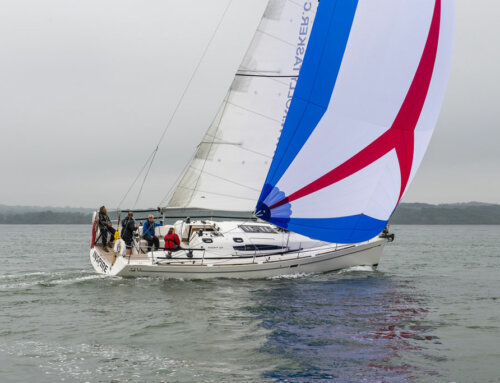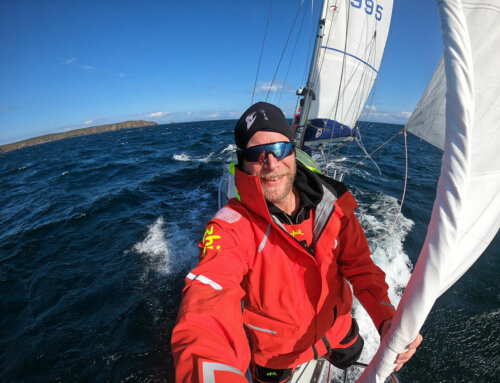What we need to look at when specifying a new mainsail: Despite many options, this is simpler than it may seem at first glance. To make it easier, we will concentrate on the Bermudian rig in this article, as the vast majority of modern yachts are rigged in this way. Despite the fact that, unfortunately, a triangle is not a very efficient shape in aerodynamics.
THE BASICS
In a Bermudian mainsail, a pronounced roach (a long, outwards curving leech) is one way to improve the efficiency. Or, to take it one step further, a fat head or square top main, which are becoming more and more common on race boats, but also on multihulls (without a fixed aft stay). When sailing upwind, it is the aft third of the sail that delivers the drive. Sailing downwind, you need the maximum projected area. Both factors are improved by roach. However, the size of the roach is limited for practical reasons, not least through the fixed backstays of most boats.
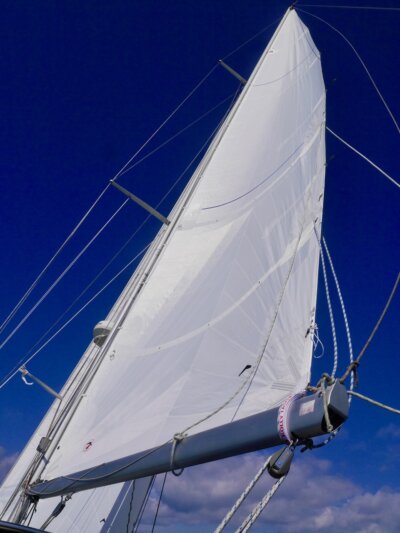
Careful profiling and good shape will again increase performance. This depends on the design and cut of the sail and on the fabric that it is made of.
DESIGN AND FABRIC
Today there is a wide choice of materials available for sails, from Dacron cloth – which we use for our inshore and coastal sails – to top level, high-end racing sails where the fibres, often carbon, are laid exactly along the calculated load lines in the sail fixed in an advanced laminate, often also referred to as membrane sails – like our Tape Carbon Performance Sails – and many variants in between. It all depends on your type of boat, sailing and also budget.
A reliable and proven solution used by many thousands of sailors around the globe are cross-cut Dacron sails which offer the best in performance and quality to cost relation. For the average family and week-end sailor, this is the most popular option. Slightly more advanced is a Tri-Radial cut mainsail made from Dacron, where the panels of the sail run from head, tack and clew towards the middle, generally following the main load lines. This also allows for the leech to be made of heavier cloth than the front part of the sail, where loads are significantly less, saving weight and making handling easier. These sails would be ideal for more extended offshore sailing or racing at club level.
One step up from our Dacron sails would be the Performance Sails made from different laminates, such our CDX Pro Laminate, our Lite Skin range of fabrics or the already mentioned, high-end Tape Carbon sails. All these are highest quality sails for the performance minded sailor, either venturing offshore or racing at competitive level.
SAIL BATTENS
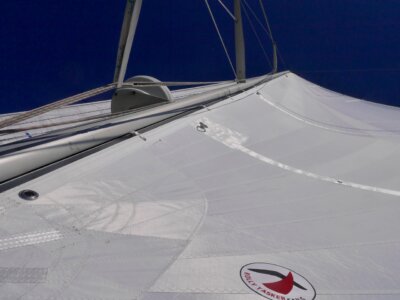
Cross-cut Dacron sails usually have several short battens to support the leech which work fine with sails that are not too big. These sails are easily hoisted, lowered, reefed and folded on the boom. However, when reefing these sails will flog more than those with longer or full-length battens, increasing wear. But for relaxed inshore or coastal sailing, this set-up will be the easiest.
Full-length battens, or fully battened sails, are often used on larger mainsails as these are then easier to handle when lowering – a fully battened sail in combination with lazy jacks and a fixed sail cover on the boom will more or less stow itself away when taken down, as it will fold itself into the boom bag aided by the battens. This sail will not flog when reefed or taken down.
On the downside, full-length battens add pressure on the luff and hoisting the sail will be more of an effort – even more so if the halyard is led aft to the cockpit, increasing friction along the way. This is the reason why these sails are hoisted on ball-bearing batten cars running along a mast-track. If the battens are too stiff or not inserted into the sail with the right amount of tension, they will determine the profile of the sail in a way that may not necessarily be in line with the designed profile. Finally, full-length battens tend to increase chafe of the sail against lower shrouds when running downwind.
A combination of both types of battens and a good compromise are sails with only one or two full-length battens at the top to stabilise the sail and its profile, and short battens
LEECH-LINE
The wind flowing along the sail and leaving it at the leech will often cause this to flutter, disturbing the air flow but also greatly increasing wear of the sail. To stop the leech from fluttering, a line is run along the leech, usually from the top, where it is fixed, to the bottom, where it can be tightened and fixed in a small cleat. On boats where the boom is so high that it cannot be reached from deck, the line is the other way around – fixed at the bottom, then running the length of the leech to the top, where it is led through a small block and down along the luff to the foot of the mast from where it can be adjusted.
CUNNINGHAM
This trim item, a ring like those for the reefs on the luff but only a short distance above the tack, is used mainly by racing sailors to flatten the profile of the main when sailing upwind in blustery conditions – when the wind is just too strong for the normal sail profile but not yet enough to take in the first reef. Which cruising sailors would usually do, and rightly so, under the same circumstances. A Cunningham tightens the luff of the sail, reducing the depth of the profile and pulling the deepest point forward, de-powering the sail. When rounding the top mark and bearing off, it can quickly be released again so that the sail will then once more be fully powered with the original profile.
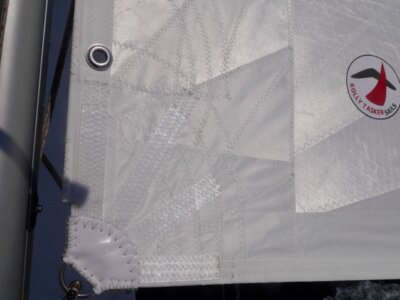
LOOSE OR FIXED FOOT OF THE SAIL
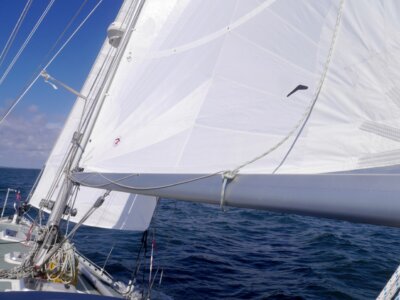
Tensioning or loosening the foot of the sail will directly affect the profile. More tension translates to a flatter sail, good in stronger upwind conditions. Less tension gives more depth of the profile, useful in choppy conditions where you need maximum drive to get through the waves, or when sailing off the wind. Having a loose-footed main or one that is fixed along the boom does not change this principle and is probably more a question of personal taste. Some prefer the sail to be fixed to the boom along its length, others prefer the loose foot where the sail is only attached by the tack and the clew as the simpler solution.
REEFING
Many racing dinghy or open keelboat classes for inshore, around-the-cans racing do not even have any reefing option, but for cruising and offshore sailing, adequately placed and strong reef points are imperative to have. Coastal cruisers might only have two reefing lines, but offshore yachts need three deep reefs. Reefing puts considerable strain on the sail so reefing points must be generously strengthened with large, multi-layered pads to spread the loads.
ALTERNATIVE WAYS OF REEFING
Reducing sail area with reef lines and cringles is the most reliable way of performing this task. However, several other ways of doing this have been developed in an attempt. To make it easier for the crew. Single-line reefing, where both luff and leech are pulled down onto the boom with one single line which is led aft to the cockpit, as is the mainsail halyard, can work well on smaller boats. In recent years, furling mainsails have become more and more popular. These will be either in-mast or in-boom furling systems.
WHICH TYPE OF SAIL IS YOURS
This very obviously depends on the type of boat and the type of sailing that you are planning. Cross cut Dacron sails are very good value for money for the vast majority of casual cruisers. From here on, you can choose more advanced sails designed for serious offshore sailing or competitive racing as described above. If in doubt, your local Rolly Tasker Dealer will always be happy to discuss your individual requirements.


